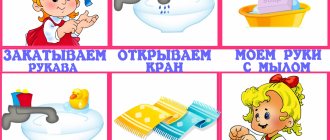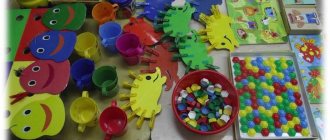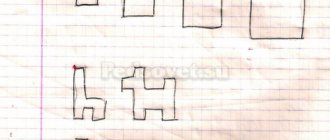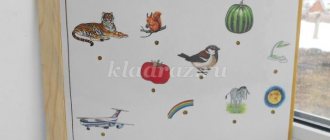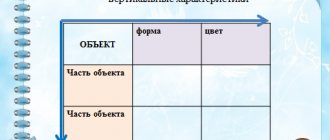Master class “Simple secrets of a speech therapist teacher”
It is necessary to re-cap and re-cap.
The bell needs to be re-belled and re-belled.
Sensory development.
The sensory development of a child is the development of his perception and the formation of ideas about the external properties of objects: their shape, color, size, position in space, as well as smell, taste, etc. It is the foundation of general mental development.
A child's readiness for school largely depends on his sensory development. Research conducted by child psychologists has shown that a significant part of the difficulties that children encounter during primary education (especially in 1st grade) are associated with insufficient accuracy and flexibility of perception.
There are five sensory systems through which a person experiences the world: vision, hearing, touch, smell, taste.
In the development of sensory abilities, an important role is played by the development of sensory standards - generally accepted examples of the properties of objects. For example, the 7 colors of the rainbow and their shades, geometric shapes, the metric system of measures, etc.
To develop sensory abilities, there are various games and exercises that will help unleash the child’s creative potential and enrich his emotional world.
The following games will help you develop your senses:
"Catch the Pussy"
The teacher touches different parts of the body with a soft toy (pussy), and the master class participant, with his eyes closed, determines where the pussy is. By analogy, you can use other objects to touch.
"Wonderful bag"
Objects of different shapes, sizes, textures (toys, geometric shapes and bodies, plastic letters and numbers, etc.) are placed in an opaque bag. We suggest that you find the item you need by touch, without looking into the bag.
"Find a Pair"
Material: plates covered with velvet, sandpaper, foil, corduroy, flannel.
The child is asked, blindfolded, to find pairs of identical plates by touch.
"Jingling Bottles"
Can you recognize sounds? This can be done, for example, with the help of such a game. Place a variety of objects in identical opaque bottles: rice, beans, peppers, river sand, pebbles, pushpins, buttons, peas, etc. Find bottles with the same sound.
"Mosaic"
Collect the drawing. Name the colors.
"Lacing"
Lace up the felt animals.
"Crab"
Unfasten and fasten the round shapes to the buttons, name the colors.
Final part. Reflection. (5 minutes)
Various methodological developments were presented to your attention. In my opinion, all this is very interesting for children. Some can be used at home, some can be used by each of you in your studies. I tried to select the material so that it could relate not only to speech therapy classes, but also to general developmental ones. Did you find something useful for yourself?
Finger games for speech development
The essence of the finger motor skills lesson is to teach the child to use his fingers to depict some objects or living beings. In this case, all finger movements must be explained to the baby. This will help the child understand concepts such as “top”, “bottom”, “right”, “left”, etc. After the child learns how to do the exercises himself, you can try to act out scenes or short fairy tales, distributing the roles among yourself and your little actor (for example, a meeting between a hedgehog and a bunny in the forest). Here are some examples of such exercises.
- Finger game “Bunny”. The index and middle fingers are straightened, the rest are clenched into a fist. Little man. “Run” with your index and middle fingers on the table. Finger game “Hedgehog”. Clasp your hands, straighten the fingers of one hand and the thumb of the other. Cat. Connect the middle and ring fingers with the thumb, raise the index and little fingers up. Horned goat. The index and little fingers are straight, the thumb is on the bent ring and middle fingers. Butterfly. Cross your hands at the wrists and press your palms with the backs of your hands facing each other, fingers straight; palms with straight fingers make slight movements in the wrists - “butterfly flies.” Glasses. Fold the fingers of your right and left hands into rings and bring them to your eyes.
In addition to these examples, you yourself can come up with many interesting and entertaining exercises for your child to develop speech.
Active gymnastics: games for developing speech using fine motor skills
Game aids:
- Butterflies made of colored paper
- Leaves of colored paper
- Pinwheel
- Cotton balls
- Paper boat
Games for children from 2 months:
- That's how different they are. Objects of various textures and shapes are placed in the child’s hand. The baby must grab the object and hold it for a while. This exercise develops not only motor skills, but also tactile sensations. It’s good if you comment on what is happening: “This ball is smooth,” “This hedgehog is prickly,” etc.
Games for children from 9 months
- Prefabricated nesting dolls. First you need to collect one doll, then gradually complicate the game; after 2 years it should be a triple matryoshka.
- Pyramids. First you need to use a classic pyramid, the size of the rings of which decreases towards the top.
- Trace along the outline. You need to make cards with images of objects known to the baby, for example, a house, a tree, a car, and paste over their outlines with velvet paper. The essence of the game: an adult guides the baby’s finger along the contour and names the object. Then the outline is covered with beads or peas and the game is repeated.
- Cups and spoons. The child uses a spoon to pour sugar or semolina from one cup to another. You can also transfer beans, peas or nuts by hand.
- Modeling from plasticine. You need to start with a cylinder, and over time complicate the tasks: a ball, a carrot, a snake.
During the games, do not forget to comment on your actions and explain to your child everything that you do.
Games for children from 1 year:
- Strong palms. The child squeezes rubber toys. The best thing is the rubber hedgehog: the needles act like a massager.
- Mosaic. First you need to lay out simple shapes: paths, flowers, squares, and then move on to more complex ones: houses, cars, Christmas trees.
- Constructor. The size of the parts and the complexity of the design depend on the age of the baby: you need to start with the largest parts and the simplest structures, for example, building a turret.
- Beads. The size of the beads also depends on the age of the child. First, instead of beads, you can use balls from pyramids with round parts and string them on a thick cord; then the size of the parts must be gradually reduced, moving on to real beads. For the exercise, medium-sized beads already strung are used. The goal is to teach the child to lay out the outlines of objects from beads. For example, you can lay out a circle, square, heart, spiral, etc.
- Laces. Since lacing has different contents, it makes sense to play with the lacing process - for example, ask the child to sew a dress for his mother (lace-button) or lace shoes (lace-boot).
- Magic tray. Sprinkle a thin layer of semolina onto a tray and run the child’s finger over the cereal. The child is then shown how to draw various shapes. At the age of 2 - 3 years, you can draw numbers and letters.
- Multi-colored clothespins. The essence of the game is to teach the child to independently attach clothespins, and to make the game interesting, you can do this according to a thematic principle: rays to the sun, needles to the hedgehog, rain to the cloud, grass to the ground. Of course, for this you first have to make preparations. This is a rather difficult task for a child. Don't try to achieve results right away. To begin, take the baby’s hands in yours and do the exercise with him.
- Cinderella. You need to mix white and red beans and ask your child to sort them by color.
- Funny pictures. Spread the plasticine evenly over a sheet of cardboard and show your child how to lay out drawings using peas.
- Counting sticks. Show your child how to use counting sticks to lay out different shapes. It is advisable that the counting sticks are not smooth, but ribbed: this serves as an additional massage for the fingers.
- Little sculptor. Dough modeling (dough recipe: 1 cup flour, 1/2 cup salt, a little water). The advantage of dough over plasticine in this case is that the crafts can subsequently be used as toys.
- Fasten the button. You will need two pieces of thick fabric. On one of them, sew three buttons of different diameters, in the second, cut loops of appropriate size. First, show your child how to fasten the buttons, commenting on your actions: “We insert the large button into the large buttonhole, the medium button into the middle one, and the small button into the small one.” Then take the child's hands in yours and repeat the exercise. After this, you can invite the baby to try to fasten the buttons on his own. Don’t insist if the baby doesn’t want to or if he can’t do it. This is a very difficult exercise and requires practice to perform successfully.
- Stencils. It is recommended to start with stencils for internal tracing (it is easier for a child to trace inside than outside) and with the simplest shapes (circle or square). Practical advice: you can buy ready-made stencils, but it is better to make them yourself. The fact is that most standard stencils are small in thickness, and it is inconvenient for a child to trace them, since the pencil keeps slipping off. Therefore, the stencils must be quite voluminous. A good solution is to cut them out of a piece of linoleum or a shoebox.
Finger Theater
Finger theater is an exciting game that:
- Stimulates the development of fine motor skills;
- Introduces the child to the following concepts of shape, color, size;
- Helps develop spatial perception (the concepts of “right”, “left”, “next to each other”, etc.);
- Develops imagination, memory, thinking and attention;
- Helps develop vocabulary and activates speech functions;
- Forms creative abilities and artistic skills;
- Introduces basic mathematical concepts.
For children aged 1 – 2 years (using the example of the fairy tale “Kolobok”):
- First, introduce your child to the characters in the fairy tale. Invite your child to look at and touch the figures. Then put each character on your finger in turn and describe it.
- Introduce your child to the name of each finger on his hand. For example, you can say this: “I have a Kolobok sitting on my index finger.”
- Then act out a fairy tale for your child. Place the characters on your fingers and cross your arms. Start telling the story, raising your fingers with the characters as the action progresses. For example, the fairy tale “Kolobok” can be told as follows. Thumbs up with Grandma character. Tell your child that today this hero will bake Kolobok. Rhythmically tap the heels of your palms against each other without releasing your fingers. At the same time, say: “Grandma is kneading the dough.” Using the same principle, play up the appearance of each character.
For children aged 2 – 4 years (using the example of the fairy tale “Kolobok”):
- Ask your child if he remembers the fairy tale “Kolobok”. Remind him if necessary.
- Then ask your child to place the characters on the table in the order they appear in the story. At the same time, ask to characterize each of them according to the principle: “Grandma is old, kind, caring; Kolobok is round, ruddy, mischievous,” etc.
- Ask your child questions about the fairy tale. For example: “Why did grandma decide to bake Kolobok? Why did he leave his grandmother and grandfather? Who did he meet on the way?
- Then act out a fairy tale in front of the little spectator using a finger theater.
- At the end, ask your child to act out a fairy tale in front of you using a finger theater. If necessary, prompt him.
